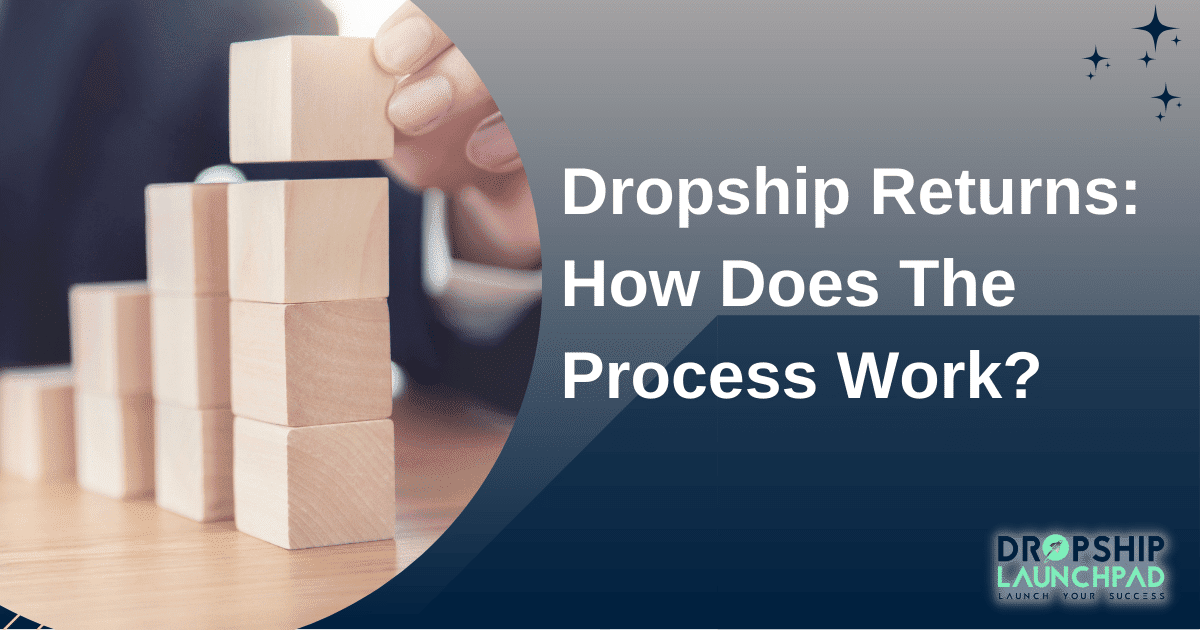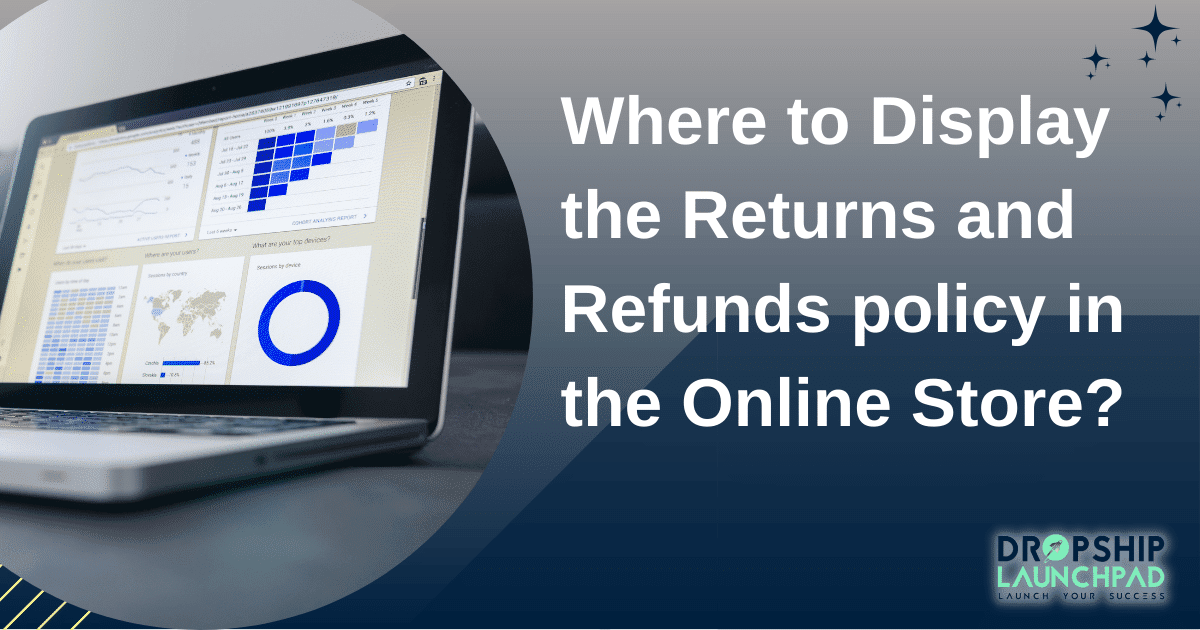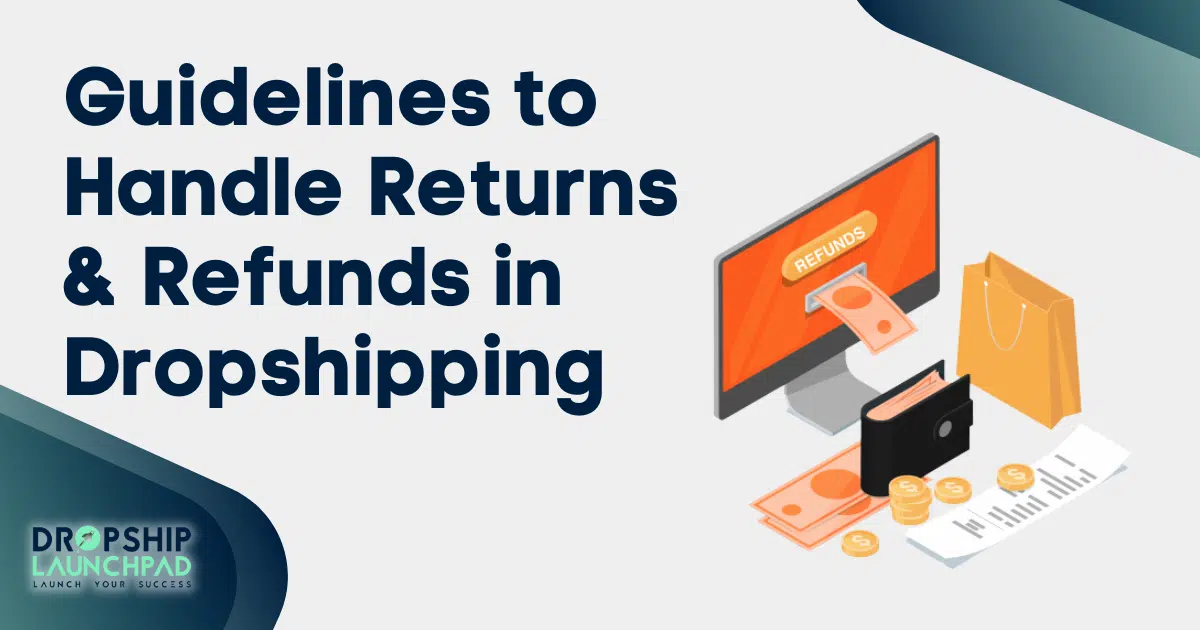As a dropshipping business owner, you will inevitably have to deal with returns and refunds at some point. It’s essential to understand the process to handle these situations as efficiently as possible.
This article will outline the steps you need to take when someone requests to accept returns or refunds. So, read the following comprehensive guide to successfully handle returns and refunds in dropshipping.
What are returns and refunds?

Returns and refunds (also called returns and cancellations in some contexts) are when clients are not satisfied with their purchases. It means that they ask for their money back, or if they’ve already received the product, they ask to return it.
This may seem like a straightforward concept on paper, but customers can sometimes be a little trickier. In some cases, they might ask for a refund because their product arrived late even though you specified the correct shipping time in your terms and conditions.
In other cases, they could try to get a refund by claiming the product is faulty when it isn’t. To make things worse, they can sometimes file a chargeback with their bank and get their money back even after receiving the product.
Dropshipping refund requests: common causes

There are several reasons why customers request returns and refunds, such as:
The product was different from what they expected.
Refund requests are caused mainly by the product your customer got delivered does not match your store’s description.
The product they received was faulty or damaged.
In some cases, a customer might receive a product that doesn’t work or is damaged – the courier company can cause this.
They changed their minds about the purchase.
Some customers will request a return if they change their mind about a purchase they made. It could either happen immediately after they make the purchase, or it could happen a few weeks down the line.
The quality of the product is poor.
It’s also possible that your customer might request a return because they think the product is of low quality. This can be caused by you having chosen the incorrect low-quality product supplier.
The product arrived late.
Some customers request returns because the product they purchased arrived later than expected.
They want to change the product or size.
Your customer may want to switch their purchase for something more suitable.
Charged the wrong amount
Sometimes customers will request a refund because they were charged the wrong amount. This can happen if you don’t include shipping costs in your base price or if your pricing is unclear.
They received the wrong item.
Finally, another common reason for return requests is when your customer receives the wrong product. It can happen because you accidentally choose the wrong color or size or accidentally purchase a completely different item than what your customer wanted.
In most cases, customers usually do not return items because they don’t like them. However, people will sometimes try to get a refund by claiming the product is faulty. As a dropshipping business owner, this can be frustrating because it seems like the customer is trying to take advantage of you. You should, however, be careful not to be too quick to judge the customer. Keep in mind that sometimes products are genuinely faulty.
If a customer returns or refunds an item, you’ll have to refund them according to your returns and refunds policy so that the money goes back into their account. Depending on your business model, you can either offer a full refund, an exchange for another item, or store credit.
Dropship returns: How does the process work?

The dropship Returns process includes the following steps-
#Step1: You will receive a return request from the customer who purchased the item from your store.
#Step2: You need to start your return process by informing your supplier.
#Step3: Your supplier issues each customer a return merchandise authorization (RMA) number.
#Step4: In this case, the customer will return the product to your supplier, along with the RMA number.
#Step5: After the supplier has approved and accepted returns, the wholesale price will be refunded to your account.
#Step6: Upon receiving the supplier refunds, you will refund the customer.
The entire process from return request to refund may take some time, depending on the supplier’s return policy.
Guidelines to handle returns and refunds in dropshipping

If you ignore how you handle returns and refunds, it can end up hurting your business. This is why you must understand what you need to do in this situation.
The process of issuing a return or refund should be easy for your customer because they are already unhappy with the purchase. If they have to wait a long time to get their money back, they might get frustrated and leave negative reviews about your business. In this case, you will have no one but yourself to blame.
You must work as efficiently as possible to give the customer what they want as soon as possible.
Make straightforward returns and refunds policy.
You must have a straightforward returns and refunds policy so that your customers know what to expect.
You need to have a clear return and refund process, as well as rules on who is responsible for the return shipping costs. This way, your customer knows exactly what to do if they want to return an item.
Before making your returns and refunds policy, you should know your suppliers’ return policies as well. Some suppliers might require you to provide a specific reason for your returns, while others charge restocking fees.
If you work with multiple suppliers, make sure to ask them separately about their return policy and return address.
Offer a flexible refund policy.

You need to have flexible returns and refunds policy because it shows your customers that you are willing to listen. By offering this, you will encourage them to come back if they have any additional concerns about your goods or services in the future.
It’s also crucial that you do everything you can to resolve the issue and also to keep your customers happy.
Offer store credit to your customers.
If you are unable to offer a full refund or exchange for any reason, it’s essential that you at least offer store credit. This way, your customer gets some compensation for their time and effort even if they cannot get their money back entirely.
Offer returns on items that are not opened
Many suppliers have a returns policy that only applies to items that have not been opened. Some products can be easily damaged by being used or opened, and they will also not qualify for a refund.
However, you should always offer a full refund on any unopened item so that your customers are satisfied with their purchase.
Handle the requests as quickly as possible
When customers request an exchange or refund, you must work efficiently to receive what they want as soon as possible. This means that you should handle requests within 1 or 2 days.
Offer the best solution possible.
You must offer your customers a solution that they are satisfied with. It is often the best solution that you can offer them at the moment.
Provide your customers with a simple return process.

It can be very frustrating when your customers have to request a return. So, you should make the process as easy as possible for them to be satisfied with their purchase.
If you follow this, customers will be satisfied with their purchases because they know it won’t cause them additional frustration or hassle.
Step by step guide to dealing with customers who want refund or return
Here are the steps you need to take when dealing with customers who want a refund or an exchange.
- First, thank them for their purchase and let them know how much you value your customer. If they have any problems or concerns about your goods or services, it’s essential to address this as quickly as possible to satisfy their purchase.
- Next, let them know that you understand they might not be happy with the goods they received, and it’s important to listen to their concerns. Then apologize for whatever inconvenience caused them. By doing this, you show your customer that you are willing to make things right to be satisfied with their purchase.
- When you know their concerns, tell them the best solution possible to satisfy their purchase. If there is anything else they need, show them how you can help by being polite and courteous.
- Finally, thank them again for their purchase, and let them know that you look forward to working with them in the future.
Dropshipping: Why Are Returns and refunds Policies important for business?

Dropshipping business model is very lucrative in which you sell items online without owning them. Consequently, you will need to rely on your suppliers to handle and ship the product to your customers.
This means that when customers are unhappy with their purchase, it’s essential that you work with your supplier so that they can get an exchange or a refund.
There are a few reasons why returns and refunds policies are important for businesses.
First, businesses need to have a clear and concise return and refund policy to set expectations for their customers. If customers know what to expect from a company regarding returns and refunds, they’re more likely to be satisfied with their purchase. Additionally, if there are any problems with a purchase, customers will know exactly what to do to get their money back.
Second, businesses can protect themselves from fraudulent activity by implementing returns and refund policies. If someone tries to return or refund an item that they never actually purchased, the business can use their policy as proof that the transaction was not legitimate. This protects the business from loss.
Clear and concise returns and refund policies help you build trust with your customers and encourages them to shop with you again. Which means it increases your customer loyalty.
If you don’t offer returns or refunds, customers may be hesitant to buy from you, as they won’t be able to return the product if they change their mind or the product is faulty. Offering returns and refunds shows that you value your customers and are willing to put their needs first. This can encourage them to shop with you again in the future.
Return Policy: What Should Be Included?

Return policies should outline how items can be returned and refunded when they are faulty or damaged, not as described, or received incorrectly. Generally, a return policy should include-
- Information about the timeframe in which customers can return items,
- What items are eligible for a return,
- How these items will be exchanged (if possible),
- Include the information if there is a restocking fee associated with the exchange,
- Mention who will cover return costs if necessary.
- What payment method should be used if an item is returned.
- The conditions in which they are entitled to a return and reimbursement will depend on your return policy.
- Businesses need to list the conditions that must be met for a customer to receive their money back after returning an item. This ensures that customers follow proper procedures and protects you from potential product loss or revenue if they take advantage of you.
- You should provide your customers with step-by-step guidelines about returning or exchanging an item.
This information can vary depending on your product and industry, so it is essential to include as much information as possible so customers know what they need to do if there is a problem.
Some pro tips to minimize returns and refunds in dropshipping

Let’s learn some strategies to make customers happy and prevent returns on your eCommerce store!
Work with trustworthy suppliers with good quality products.
It’s important to work with suppliers who provide good quality products to reduce the number of returns you receive.
Before choosing a dropshipping supplier, you should do your research and ask them about their product quality to ensure that you’re providing your customers with high-quality items.
It’s also important to regularly check your supplier’s reviews, as it will help you choose the best supplier for your business.
Communicate with your supplier
It’s important to communicate any problems you’ve experienced with a product or service provider to resolve them.
If your customers receive a poor-quality product, don’t wait until it repeatedly occurs before contacting the seller and asking for a replacement. Communication is essential for a successful dropshipping business. If you’re having problems with your supplier, tell them about it. They may not know what’s going on if you don’t contact them or there are delays in getting back to you.
Watch for any changes to the product photos and the actual product.
If the difference is significant enough that customers might not be pleased with their purchase, it’s important to let them know about it. It can be done by sending an email or updating the product description on your website.
Customers are likely to be more satisfied with their purchase if you let them know in advance that the item they’re receiving will look different than the advertised product, which will minimize returns and refunds.
Take care of leads
It’s important to take care of leads to reduce the number of returns you receive.
If your customers are having problems with their purchase, they will likely contact you to solve this problem, and if you don’t respond timely, they’ll probably feel frustrated.
Providing good customer service and responding promptly to inquiries can easily solve leads and customer complaints problems.
Every business must provide the best possible experience for every customer, even accepting a return or refund.
These returns will accumulate, so it’s important to keep track of customer complaints and feedback to avoid receiving two requests for the same reason.
Describe products clearly and comprehensively for your customers.
Clear product descriptions will help avoid returns and refunds by informing your customers about the specifications of the item they’re looking at.
Customers who have questions or don’t understand how something works; you can answer their queries before they have a chance to ask for a refund because they didn’t receive what they ordered.
Make sure your product images are high-resolution.
It’s crucial to provide your customers with high-quality product images so they can see precisely what the item looks like.
If you want to reduce returns, make sure that your customers are clear about what they’re buying before it arrives by sending them photos of the items they’re looking at.
Describe all terms and conditions in your policies
It’s important to describe all terms and conditions in your return and refund policy so that your customers know what you allow and don’t allow.
Since this significantly impacts the number of returns you receive, it’s essential to clearly outline the terms and conditions of any policies you set up for refunds and returns.
Make sure your products reach timely to your customers.
You should keep your customers updated on the delivery process of their orders.
If there are any delays in delivering the product, they will need to know why this has happened so that they don’t negatively affect your business.
Offering great customer service will help to reduce returns and refunds.
It’s easy for customers to blame their poor experience on the product they received, but maybe it was your team that let them down by failing to provide a satisfactory experience.
For example, if you offer free shipping as part of your service, it’s important to get it right the first time by successfully sending the order to the customer.
When customers are satisfied with their purchase, they will share their experience with friends and family through word-of-mouth advertising which is one of the best types of marketing you can use.
On the other hand, if your business fails to provide good customer service, your customers may go public with their complaints which can have terrible consequences.
How to Handle refunds quickly and efficiently?

Quickly and efficiently handle refunds by creating a process for it.
First, develop a policy for refunds. This policy should be clear and concise. Stating the conditions that must be met to qualify for a refund and the timeframe within which a refund must be requested.
Make sure your refund policy is easy to find on your website. You need to be prepared to issue refunds promptly and courteously when customers request them.
Next, create a system for processing refunds. This system should include an online form for customers to request refunds and a set of instructions for returning products.
Finally, make sure your staff is familiar with the policy and the system for processing refunds. It will help ensure that customers receive prompt and accurate service when requesting a refund.
Where to display the returns and refunds policy in the online store?

No one-size-fits-all solution exists for this question, as the best place to display your return policy will vary depending on the specific nature of your online business. However, some good ideas for places to prominently display your return policy include:
– On your website’s homepage
– Near the checkout process
– On product pages
– In your shipping and returns policy document/page
Q&A about returns and refunds in dropshipping

Q: Do you offer returns or refunds if the product is damaged in transit?
A: Yes, all carriers will cover damages during transit. In case the product arrives damaged, notify the carrier right away for a refund. In that case, you can offer free returns to your customer.
Q: How should I deal with a customer who orders but does not pay?
A: Some customers will not complete their orders after submitting them once they’ve realized they don’t want or can’t afford the item anymore. Just cancel the order and move on.
Q: What happens if my customer places an order and pays, but I can’t complete their order?
A: The situation is similar to the one above, except this time you’ll be able to send your customer a refund or replacement item, so they leave happy. Just be sure that you’re fulfilling your inventory properly, or this could happen again.
Q: What should I do if a customer wants to cancel an order in transit?
A: If a customer canceled an order mid-transit, the best thing to do would be to reach out to them and see if there’s anything you can do to help. Maybe they changed their mind about the order or had a problem with their shipping address. If it was something you could have fixed, it’s crucial to make things right for the customer.
But if the customer canceled the order because they didn’t want it anymore, you might have to issue a refund. In that case, you may ask your customer to cover return shipping fees. Then, after returning the product, you’ll need to issue a refund through your payment gateway.
Q: What if an order was partially canceled?
A: If you can cancel part of an order, then refund the remaining balance back to the customer. If only part of the order was returned for some reason, then you’ll need to issue a partial refund back to the customer’s credit card or PayPal account.
Q: How do I process returns and refunds in dropshipping business?
A: Using your online store software, create a system for processing returns and refunds according to your supplier’s policy. For example, if customers receive damaged products, you need to go into your inventory and create a return label. The system should also account for tracking and filing the return/refund request in your accounting software.
Conclusion
The guidelines we’ve laid out in this blog post will help you minimize returns and refunds in dropshipping. This way of thinking about your supply chain could save you time and money by helping you avoid these situations.
Have any good examples of how using the tips mentioned has helped? Please share them with us!
We would love to hear what other success stories people have had following our advice. Let’s work together on creating an even more successful business for everyone involved – customers, suppliers, and retailers alike!

 Can I Really Make Money with Dropshipping?
Can I Really Make Money with Dropshipping?  10 pro tips to make your first dropshipping sale in 2023
10 pro tips to make your first dropshipping sale in 2023  2023’s Top 5 Dropshipping Ecommerce Platforms
2023’s Top 5 Dropshipping Ecommerce Platforms  2023’s Top 10+ Great Dropshipping Store Branding Tips
2023’s Top 10+ Great Dropshipping Store Branding Tips